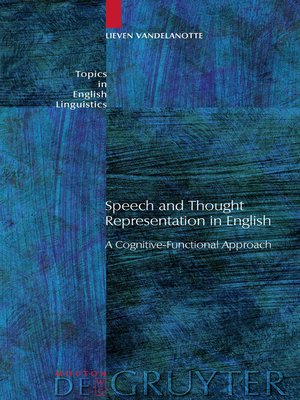Speech and Thought Representation in English
ebook ∣ A Cognitive-Functional Approach · Topics in English Linguistics [TiEL]
By Lieven Vandelanotte

Sign up to save your library
With an OverDrive account, you can save your favorite libraries for at-a-glance information about availability. Find out more about OverDrive accounts.
Find this title in Libby, the library reading app by OverDrive.



Search for a digital library with this title
Title found at these libraries:
| Loading... |
This book aims to provide a new, linguistically grounded typology of speech and thought representation in English on the basis of the systematic study of deictic, syntactic and semantic properties of authentic examples drawn from literary as well as non-literary sources.
In the area beyond direct and indirect speech or thought, 'free indirect discourse' has often been implicitly treated as a residual category that can accommodate anything that is neither one nor the other. This book takes a fresh look at the evidence in the area of deixis, particularly through a close study of pronoun and proper name use, and proposes to distinguish the more character-oriented free indirect type from a narrator-oriented 'distancing' indirect type, which is grammatically wholly structured from the narrator's deictic standpoint. Unlike free indirect representations, which coherently represent the character's viewpoint, the distancing indirect type sees narrators appropriating character discourse for their own purposes, which may for instance be ironic. The distinctions thus drawn shed new light on the much debated 'dual voice' approach to free indirect discourse.
Included in the scope of this book are subjectified uses of clauses such as I think, which no longer primarily construe a cognition process, but rather come to function as hedges. Such speaker-encoding uses are argued to involve an interpersonal type of structure, not based on complementation, whereas the non-subjectified cases receive an interclausal complementation analysis which does not have recourse to the problematic notion of 'reporting verb'.
This monograph is mainly of interest to researchers and graduate students interested in the syntax, semantics, and pragmatics of reported speech viewed from a constructional perspective.






